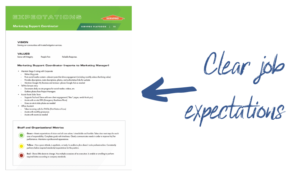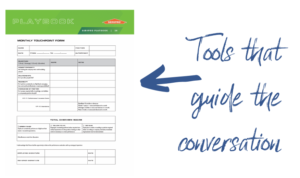12 Tips for a Monthly Touchpoint Performance Review
Monthly touchpoints are part of a continuous performance review conversation model. Regular meetings with feedback lead to greater alignment, accountability and healthy culture. It’s a tactical approach to move your team in a positive direction toward the vision and values of your organization.
What is a Monthly Touchpoint Performance Review?
A monthly touchpoint is a frequent performance review, a two-way, individualized conversation between managers and employees about performance impact, development, and growth.
These conversations significantly impact the success of your employees, teams, and organization as a whole. It’s an ongoing approach that allows for more flexibility to address issues and course-correct while developing deeper trust throughout the team.
1. Performance review conversations should happen frequently.
Monthly touchpoints are regular performance review conversations, paired with a year-end review of general themes, notes, progress, and next steps. Frequent conversations allow team leaders and employees to stay on the same page about goals, progress, and performance. Regular discussions can be brief, robust, and comprehensive to be effective.
2. Reduce any anxiety – keep it transparent.
Meeting with team leaders can be anxiety-inducing. To help reduce anxiety, bring employees into the process early. Team leaders should work with the employee to create clear, shared, and collaborative agenda items. Both parties should know exactly what to expect with no surprises.
3. Communicate performance criteria.
Team leaders and employees should clearly understand what constitutes good or poor performance—and this starts with the organization clearly communicating job expectations. Focus on what employees are doing well and uncover opportunities to course-correct. Each touchpoint conversation is an opportunity to build trust by helping allow employees to share and to be given guidance on where they need to go.
4. Consider time, location, and space.
Keep monthly touchpoints brief (15-20 min.) Also, the environment you choose for your monthly touchpoint significantly impacts the overall vibe of the discussion. So, consider location, time, noise level, and visual comfort.
5. Keep the conversation objective.
Team leaders should approach performance conversations with rich employee data and examples. Consult the HR Manager for supportive data to help guide the conversation and build a more meaningful relationship between manager and employee. Don’t rely on personal opinion.
6. Align expectations for the employee.
Team leaders and employees should have a shared understanding of what constitutes good performance. Employees should know their job expectations. By aligning expectations with your organization’s set performance criteria, the employee will feel reassured when given feedback regarding performance.
7. Consider the past, but focus on the future.
Typically, performance reviews have centered around the past—how the year went, what went well, and what didn’t go well. Employees don’t have the power to change the past but can change moving forward. This is where your performance conversations should focus – looking forward.
8. Use tools to help ask the right questions.
Use tools and forms provided by the organization to guide the right questions.
Shift your mindset from judge to coach. A few good questions to ask are:
- What accomplishment(s) from the last month are you proud of?
- Which goals did you meet? Which goals fell short?
- Have you considered goals for the this week, next month, and the next six months?
- Are there any challenges in your way?
- How can I improve as your team leader? As an organization?
- How can we make your job more enjoyable or productive?
9. Make it a positive, two-way conversation.
Keep the conversation positive, avoid approaching the conversation with an evaluation mindset, and encourage employees to ask questions of you. Words carry a lot of power; remember to be thoughtful and considerate with the organization’s best interest at heart. Invite employees to be part of the conversation, which don’t have to be just about performance. Touchpoints can also address:
- Career growth
- Understanding organizational changes
- Recognition
- Peer feedback
- Customer feedback
10. Be an active listener.
In order to have a two-way conversation, team leaders should facilitate dialogue with active listening. Strive to understand how the other person may feel and work to keep your emotions in check. Once an employee shares their feedback, repeat back what you heard to allow for accurate understanding.
11. Wrap up the conversation with agreed-upon next steps.
A monthly touchpoint should always wrap up with next steps. Team leaders and employees should review notes, define the next steps, and follow up with shared comments and feedback.
12. Keep the conversation going.
After the meeting ends, give continued support to help the employee achieve the goals that have been discussed. Be sure to put next month’s touchpoint on the calendar. Better yet, schedule a series of meetings throughout the year.
Continuous Conversations for Greater Alignment
The goal is for employees to feel comfortable discussing their performance all year long. Regular 1-on-1 meetings serve as pulse checks throughout an employee’s lifecycle. Touchpoints are good ways to move toward a continuous performance conversation model with a greater alignment toward the vision and values of the organization.



